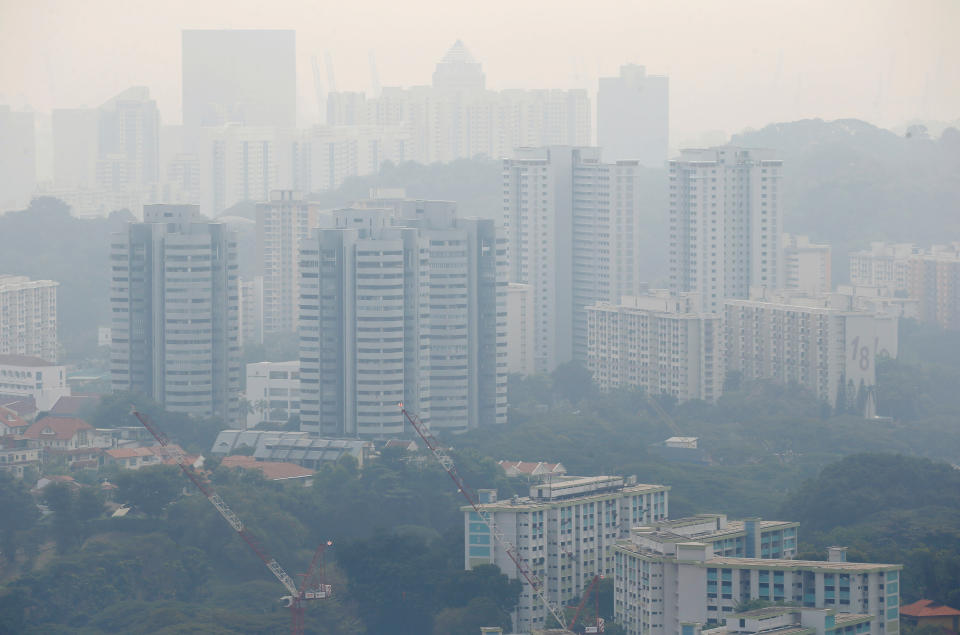Singapore’s air worsens to ‘unhealthy’ levels: Asia haze update

By Yoga Rusmana
(Bloomberg) -- The air quality level in Singapore turned unhealthy ahead of the Formula 1 race this weekend, while Kuala Lumpur was ranked among the world’s most polluted cities, as wind from neighboring Indonesia continued to sweep in ash and smoke from illegal burning of forests and farm land.
Authorities canceled schools for nearly one in seven Malaysian children as the haze worsened across the country, while dozens of flights in Southeast Asia were delayed or canceled because of poor visibility at airports. Prime Minister Mahathir Mohamad may pass a law to hold Malaysian companies responsible if they don’t put out fires on their properties outside the country.
A thick layer of smoke and ash from illegal burning to clear land for plantations mostly in Indonesia has blanketed parts of Southeast Asia in the past two weeks, causing air traffic disruptions and thousands of people reporting acute respiratory illness.
Indonesian President Joko Widodo has ordered a crackdown against individuals or companies responsible for the hotspots as they revive fears of a repeat of 2015 when a total of 2.6 million hectares of land was affected, costing Indonesia US$15.7 billion in economic losses.
Here’s the latest:
Air Pollution
Kuala Lumpur and Kuching in Malaysia, Singapore and Jakarta had the worst air quality in the world among major cities, according to IQAir AirVisual pollution data.
Singapore’s pollutant standard index rose to at least 112 on Wednesday afternoon according to official figures, a level deemed as unhealthy by the city-state’s National Environment Agency. The agency advised residents to reduce prolonged or strenuous outdoor physical exertion, while those with chronic lung or heart disease should avoid such activities.
Hotspots Status
The total number of hotspots in Indonesia fell to 2,719 on Wednesday from 2,984 on Tuesday, with Sumatra accounting for 1,425 fires and Kalimantan 732 hotspots. The wildfires have affected 328,724 hectares of forest and farm land this year, data from the National Disaster Mitigation Agency show.
Weather Forecast
There may be some relief for authorities battling the hotspots in Riau and Sumatra as Indonesia’s weather bureau forecasts some showers in the next three days. The wet weather is forecast to persist in the northern Southeast Asian region in the next few days, while dryness may persist in the southern regions, according to Asean Specialized Meteorological Centre. The hotspots activities in Sumatra and Kalimantan are likely to continue under the prevailing dry conditions.
Flight Cancellations
The haze continue to cause air traffic disruptions, with dozens of flights from three airports in Samarinda, Sampit and Berau in Kalimantan in Indonesia canceled on Wednesday because of reduced visibility, according to AirNav.
Several flights to Penang International Airport, north of Kuala Lumpur, were delayed or canceled as the haze clouded visibility at Malaysia’s third largest airport, according to Malaysia Airports.
Malaysia and Indonesia Spar
Environment ministers from Malaysia and Indonesia have traded blame on the haze situation with Kuala Lumpur offering help to put out the forest fires. Malaysian ruling party leader Anwar Ibrahim, who’s widely expected to be the country’s next prime minister, said companies must be held responsible for costs of haze. He said the menace was an ecological warfare and Malaysia must feel outraged about it.
Singapore’s Ministry of the Environment and Water Resources said the country has offered technical firefighting assistance to Indonesia and is prepared to deploy them if requested.
Schools Shut
Nearly 1,500 schools have closed across Malaysia as haze conditions worsened, affecting more than 1 million students, according to a statement from the country’s education ministry.
Singapore’s Education Ministry said earlier it would consider closing schools when the air quality turns “hazardous,” at or above 300 PSI. As of 2 p.m. local time Wednesday, official air quality scores across the island ranged from 112 to 128, according to the National Environment Agency.
Calcium Oxide
President Jokowi, as Widodo is commonly known, directed the country’s disaster mitigation agency to expand the scope of artificial rain even as authorities deployed an additional 5,600 troops and firefighters.
With the rainy season in the worst affected regions not expected until mid-October, the only lasting solution to douse the forest fires will be through artificial rain, according to the disaster agency on Tuesday. However, with smoke particles preventing cloud formation, the agency plans to sprinkle about 40 metric tons of calcium oxide to break the particles.
Respiratory Illness
Indonesia opened temporary clinics to treat thousands of people suffering from acute respiratory illness in the haze struck regions. Authorities distributed masks to people in Riau, Jambi, South Sumatra and Kalimantan. More than 9,000 personnel drawn from the military, police and disaster mitigation agency with the help of 42 helicopters are involved in fighting the fire, official data showed Monday.
© 2019 Bloomberg L.P.

